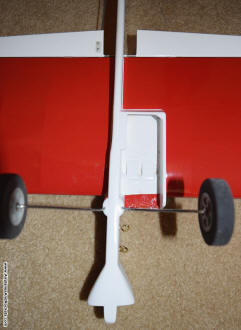
E-Shark 15 ready for its maiden flight.

E-Shark 15 framed up and ready for electric power component mounting.

Underside of the E-Shark 15.
I have been wanting to build another Jetco Shark 15
control line model airplane for a long time and finally decided to take the dive
into the project. Having sold all of my glow fuel engine support equipment (power
panel, fuel pump, electric starter, etc.) in exchange for electric power equipment,
it would be necessary to modify the airframe to accommodate a brushless outrunner
motor, an electronic speed controller (ESC), a motor timer, and a LiPo battery.
I dubbed it the "E-Shark 15." Without a whole lot of engineering calculations,
I settled on one of the two ElectriFly Rimfire .10 motors I purchased to power
my Douglas DC-3
/ C-47 twin engine control line models. A 30 A ESC with a 3-cell
(3S), 1300 mAH LiPo completed the package.
Since a Fox .15 engine mounts radially in the nose of the fuselage, a modification
was needed to create a firewall upon which to mount the Rimfire .10. Furthermore,
in order for the center of gravity to fall within the specified range, it was necessary
to build a battery box into the underside of the outboard (right) wing. All the
components are added to the right side in order to give the radial balance a bias
toward the outboard side, thereby assuring a tendency for the model to bank away
from the center of the flying circle rather than toward it if the lines go slack.

E-Shark 15 battery box construction (left).
Side note: If you are interested, see my short write-up on how to
assemble eyelets
onto the ends of the leadout wires.
Other than the noted modifications for electric power, the E-Shark 15 was
built per Jetco plans. Wingspan is 36-1/2", wing area is 270 in2,
length is 27". The fuselage was covered with Silkspan and dope, while the wings
and horizontal stabilizer and elevator were covered with Monokote. Making the landing
gear wire from 3.32" music wire was a mistake since it bent way too easily (couldn't
be from my less-than-smooth landings). If I build another, I'll use 1/8" music wire.
The E-Shark 15 had her maiden flight on September 25, 2016. Power was set
for 70% for 2 minutes using the programmable timer. I had determined that the setting
would be enough to lift the model vertically starting from zero speed. It turns
out that the 70% power level was plenty to facilitate all the aerobatic maneuvers
I am capable of (loops, figure eights, wingovers - that's about it), and should
handle even a cloverleaf.
Posted July 27, 2019
|